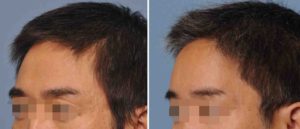Expanding or enlarging the forehead to a more desireable contour is most commonly considered in adults or teenagers who have had a congenital skull deformity. Most of these had some form of craniosyostosis, with or without early craniofacial surgery, and are now left with forehead irregularities, depressions, or a forehead that severely slopes to the temple area making it look too narrow. Other needs for forehead augmentation are from previous trauma cases with frontal bone fractures, neurosurgery patients with craniotomy defects, and rarely a female to male facial conversion patient.

Building up the forehead is similar to sculpting with clay. The forehead bone is exposed and the chosen material is applied and molded into the shape one desires. Whether it is done through an open approach when one uses the fingers to mold and shape or done through an endoscopic technique where the fingers mold it through the forehead skin, the procedure is not difficult and provides an immediate result that should not change over time. The most difficult decision for the patient is whether a larger scalp incision is acceptable or whether the endoscopic ( a few small scalp incisions) approach is preferred. Smaller or spot forehead augmentations can be done endoscopically. Larger or more complex forehead augmentations are best done with an open scalp approach.
Dr. Barry Eppley
Indianapolis, Indiana


